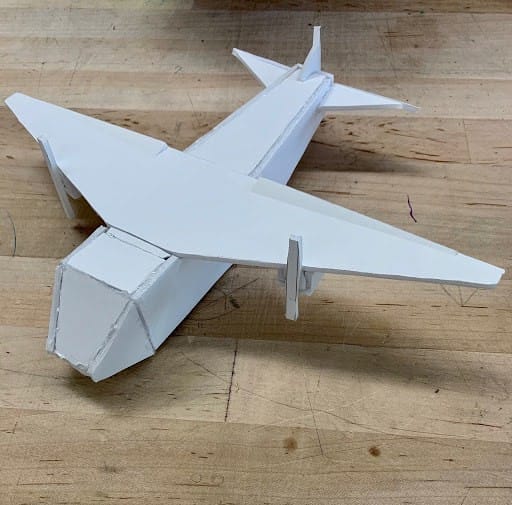On December 18th, 2019, two of our Triton UAS airframe team leads, Jessica Chan and Andrew Fletcher, got the opportunity to stay after the UCSD final exam season to attend High Tech High Chula Vista’s (HTHCV) Presentations of Learning to serve as expert panelists. They were able to attend thanks to the invitation of Marcus Artates, a 9th-grade Physics teacher at the HTHCV charter school who was previously introduced to Jessica and Triton UAS last year at a tabling event during the San Diego Maker Faire. At the Presentations of Learning, Jessica and Andrew were able to listen in during the students’ presentations and provided expert input to help improve each group’s prototype autonomous planes.
Taking place in the Tuskegee Conference room located in the San Diego Airport Authority Administration Office, our Triton UAS expert panelists as well as all the parents, teachers, and peers of the students were also present. Andrew and Jessica listened in to the students’ presentation, which included three different categories: a Kid History movie pitch, Aerospace, and Shark Tank Product Projects. Andrew and Jessica served as expert panelists during the Aerospace presentation. In this category, students proposed using autonomous airplanes to serve different purposes such as carrying and dropping seeds to plant them or dropping food aid packages.

This category involved two different student groups, both of whom Andrew and Jessica were impressed with for including most of the electronics needed for autonomous flight. The second group, in particular, included a PID controller in its list of required parts, provided the correct rationale for a high wing design, and located the payload to be dropped near the plane center gravity under the wing. As expert panelists, our airframe team leads also gave suggestions to the student groups on how to improve their planes and what other necessary electronics should be included. To the first group, Andrew and Jessica suggested the adoption of Ardupilot and Pixhawk for autopilot capabilities. For the second group, they were suggested to increase the number of electronic speed controllers (ESCs) to two, assigning one for each motor, as well as move the ESCs closer to their motors.

After the presentations, Andrew and Jessica discussed with Marcus about an opportunity to have the Triton UAS team come to HTHCV during the UCSD Winter quarter to present to students about our team and introduce them to our backup airframe, Swallow. This would be a good chance for HTHCV students to ask questions about how we develop our autonomous aerial system and apply what they learn into their own projects. They also discussed with Marcus about some of the difficulties the students may face moving forward with their aerial projects. One of the first problems was the ability to receive the necessary funding required to develop the autonomous airplanes proposed by the students. The students also face an obstacle related to some conceptual topics, such as the understanding of college-level linear controls behind PID controllers which also needs AP Calculus AB/BC experience, material that the 9th graders haven’t learned yet.
Despite these hardships, Triton UAS is looking forward to providing active support to Marcus and the enthusiastic students of HTHCV if they decide to move forward with their autonomous plane projects. There is a great deal to learn from each other given the similar nature of our projects and we hope to upkeep a strong line of communication as we progress further into the academic year. We would like to once again thank HTHCV and Marcus for giving us this opportunity to learn more about their students and the projects they’ve been hard at work with.